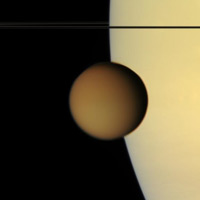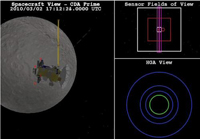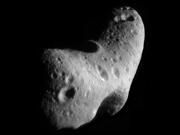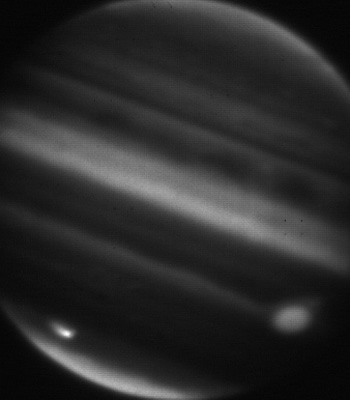Asteroid Vesta, All in the Details
Thursday, November 3rd, 2011
As NASA’s Dawn spacecraft investigates its first target, the giant asteroid Vesta, Marc Rayman, Dawn’s chief engineer, shares a monthly update on the mission’s progress.
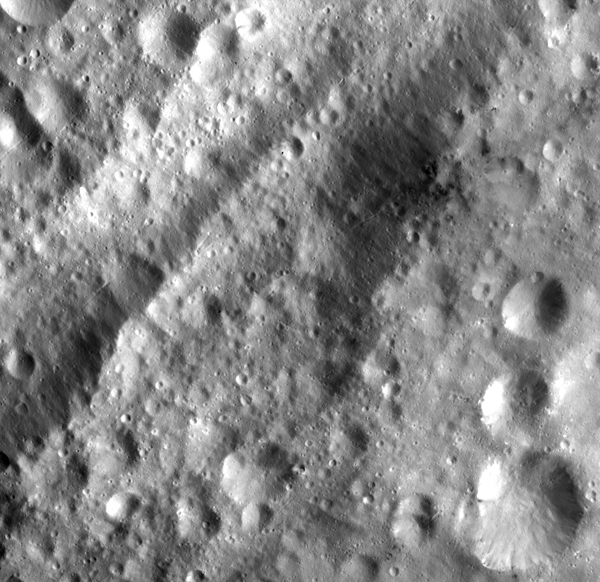
NASA’s Dawn spacecraft obtained this image with its framing camera on September 20, 2011. This image was taken through the camera’s clear filter. The distance to the surface of Vesta is 673 km and the image resolution is about 66 meters per pixel. Image credit: NASA/ JPL-Caltech/ UCLA/ MPS/ DLR/ IDA
› Full image and caption
Dear Dawnderfuls,
Dawn has completed another wonderfully successful phase of its exploration of Vesta, studying it in unprecedented detail during the past month. From the time of its discovery more than two centuries ago until just a few months ago, this protoplanet appeared as hardly more than a fuzzy blob, an indistinct fleck in the sky. Now Dawn has mapped it with exquisite clarity, revealing a fascinatingly complex alien world.
The high altitude mapping orbit (HAMO) includes the most intensive and thorough imaging of the entire year Dawn will reside at Vesta. Spectacular as the results from survey orbit were, the observations from HAMO are significantly better. From four times closer to the surface, Dawn’s sensors provided much better views of the extraordinary surface of craters large and small, tremendous mountains, valleys, towering cliffs, ridges, smooth and flat regions, gently rolling plains, systems of extensive troughs, many clusters of smaller grooves, immense landslides, enormous boulders, materials that are unusually bright and others that are unusually dark (sometimes adjacent to each other), and myriad other dramatic and intriguing features. There is no reason to try to capture in words what visual creatures like humans can best appreciate in pictures. To see the sites, which literally are out of this world, either go to Vesta or go here.
Circling the colossus 680 kilometers (420 miles) beneath it in HAMO, the probe has spent most of its time over the illuminated side taking pictures and other scientific measurements and most of the time over the dark side beaming its precious findings back to eager Earthlings.
Dawn revolves in a polar orbit around Vesta, passing above the north pole, then traveling over the day side to the south pole, and then soaring north over the night side. Each circuit takes 12.3 hours. Meanwhile, Vesta completes a rotation on its axis every 5.3 hours. Mission planners choreographed this beautiful cosmic pas de deux by choosing the orbital parameters so that in 10 orbits, nearly every part of the lit surface would come within the camera’s field of view. (Because it is northern hemisphere winter on that world, a region around the north pole is hidden in the deep dark of night. Its appearance in Dawn’s pictures will have to wait for HAMO2.) A set of 10 orbits is known to Dawn team members (and now to you) as a mapping cycle.
Although the HAMO phase was extremely complex, it was executed almost flawlessly, following remarkably well the intricate plan worked out in great detail last year. It consisted of six mapping cycles, and they were conducted in order of their overall importance. In the first cycle, Dawn aimed its camera straight down and took pictures with all of the instrument’s color filters. In addition to showing the startling diversity of exotic features, the color images provide scientists some information about the composition of the surface materials, which display an impressive variation on this mysterious protoplanet. Cycle 1 yielded more than 2500 photos of Vesta, nearly as many as were acquired in the entire survey orbit phase. These observations were deemed so important that not only were they first, but cycle 6 was designed to acquire nearly the same data. This strategy was formulated so that if problems precluded the successful mapping in cycle 1, there would be a second chance without requiring the small and busy operations team to make new plans. As it turned out, there were only minor glitches that interfered with some of the pictures in cycle 1, but the losses were not important. Nevertheless, cycle 6 did fill in most of the missing views.
Cycles 2 through 5 were devoted to acquiring images needed to develop a topographical map. Instead of flying over the sunlit side with its camera pointed straight down, the spacecraft looked at an angle. Each direction was chosen to provide scientists the best combination of perspective and illumination to build up a three dimensional picture of the surface. Knowing the elevations of different features and the angles of slopes is essential to understanding the geological processes that shaped them.
In cycle 2, the camera constantly was directed at the terrain ahead and a little to the left of the point directly below the spacecraft. Cycle 3, in contrast, looked back and slightly to the left. Cycle 4 pointed straight ahead but by a smaller angle than in cycle 2. Cycle 5 did not look forward or backwards; it only observed the surface to the right. With the extensive stereo coverage in each of these 10-orbit mapping cycles, most of the terrain now has been photographed from enough different directions that the detailed shape of the alien landscape can be determined.
The HAMO observations constitute the most comprehensive visible mapping of Vesta for the mission. The survey orbit images were obtained from a higher altitude and so do not show as much detail. When Dawn flies down to its low altitude mapping orbit (LAMO), its primary objectives will be to measure the atomic constituents with the gamma ray and neutron detector (GRaND) and to map the gravitational field. While some images will be acquired, they will be a secondary objective. The principal resources, both for the spacecraft and for the operations team, will be devoted to the higher priority science. In addition, the probe will be too close in LAMO for its camera to collect enough pictures for a global map. The subsequent observations in HAMO2 will be designed mostly to glimpse some of the northern latitudes that are currently too dark to see.























